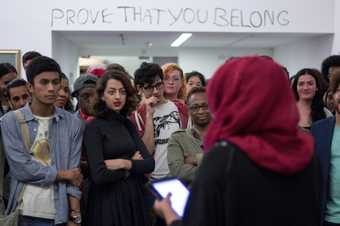Tate Schools and Teachers team commissioned artist Evan Ifekoya, and artist/curator collaborators Barby Asante and Teresa Cisneros to produce new resources that extend and deepen learning around the Artist and Empire exhibition.
These resources offer a wide-reaching introduction to the exhibition through the lens of contemporary artists’ practice.
By suggesting ways of re-framing the ideas raised by the exhibition, they offer an opportunity to contextualise the exhibition for yourselves and your students. The resources can be used both pre- and post-visit. They can also be shared directly in the classroom, and can be adapted as necessary to suit your students.
Each resource poses questions that you are invited to use to initiate activities and projects with your students in the classroom.
Evan Ifekoya

Evan Ifekoya, still from Negotiating the Porous Boundaries of Cultural Influence
Commissioned by Tate Schools and Teachers London. Teachers Resource, 2015 © Evan Ifekoya
Evan Ifekoya is an interdisciplinary artist, exploring the politicisation of culture and aesthetics. Ifekoya’s work is made up of appropriated material from historical archives and contemporary society. Ifekoya has created three original artworks in film, which explore different themes within the Artist and Empireexhibition. The three films – Map Making as Colonial Project, Negotiating the Porous Boundaries of Cultural Influence, and What to do with the past today? – intentionally play with the confusion created by the layering of images and text.
Part of Ifekoya’s research for these films led them to the 1983 work Expeditions One: Signs of Empire by the Black Audio Film Collective (BAFC). The work utilised a similar slideshow aesthetic to Evan and was produced in response to the BAFC feeling that ‘Empire was over, and yet it refused to die’. The BAFC toured the piece around art schools and galleries to raise questions and discussions around the legacy of Empire in the UK.
Barby Asante & Teresa Cisneros (agency for agency)

Baldwin's Nigger R E L O A D E D at Iniva, 2014
Photo © Barney McCann
Artist Barby Asante and curator Teresa Cisneros work together as creative collective agency for agency. In their work together they interrogate what is known about art; the politics of art and visual culture; question how art connects to contemporary life and socio-political questions; and consider the relevance of art to the world around us.
Their approach to art and art practice comes from their individual experiences of being from migrant families in the UK and US. In devising their resources – Looking Back, Thinking Now I, and Looking Back, Thinking Now II – they exchange conversations about the works in the exhibition, what they represent and how they speak to what Empire was, or is.
